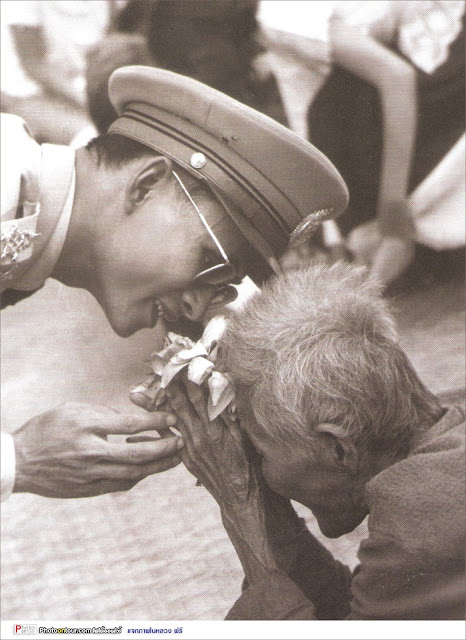King Chulalongkorn, Rama V The Fifth King of the Chakri Dynasty
'Phra Bat Somdet Phra Poraminthra Maha Chulalongkorn Phra Chunla Chom Klao Chao Yu Hua, or Rama V was the fifth monarch of Siam under the House of Chakri.'
" He was known to the Siamese of his time as Phra Phuttha Chao Luang"
Thailand Celebrates many auspicious occasions but none with more feeling or genuine sentiment than the festivities held on October 23rd every year in commemoration of his Majesty King Chulalongkorn – Born September 20, 1853, King Rama V was to inherit the throne from his father, King Monkut (Rama IV), in 1868 at the tender age of 15. Because he was still a child, Thailand was governed by regency for the first five years of his reign and the boy King took advantage of the time to travel the world. His father had been one of Siam's most educated monarchs, recognizing the need for education and also the importance of the western world, yet understanding fully the threat of colonization. Wisely, he had instilled these principles in his son who was an apt student. During those first five years, King Chulalongkorn visited most of the major western powers, learning about their cultures, traditions, political organization and technology while in neighboring countries he spent time making political friends, realizing the need for allies in the fight to prevent colonization.
On his return to Siam and absolute rule, King Rama V set about the task of reforming his country, a monumental assignment to bring Siam into the modern world. At that time there were no communication systems, ox carts and elephants were the only form of transport and government was administered in some 20 regional "Mini Kingdoms" by Governors whose only loyalty was to themselves. Taxes were collected by ordinary citizens, most of whom were thieves, and law and order was based on "Trial by ordeal" the strongest party being declared the winner of the dispute.
At home, King Chulalongkorn reorganized the Government, appointing 12 ministers, all either his sons or loyal members of the nobility, to run the country centrally from Bangkok. Faced with confrontation, he allowed the Governors of the provinces to continue in their posts but skillfully planted people loyal to the crown into positions where they were gradually able to take over. Abroad, King Rama V continued a diplomatic strategy against the colonizing powers of France and England, one notable exchange being with Queen Victoria. The British Monarch had proposed that the East India Company construct a railroad in Siam but fearful that England would use the project to trick Siam out of its sovereignty, King Rama V sent a message to Queen Victoria saying "Siam is not yet ready for a railroad due to insufficient economy and a relatively low population." He added a note that the ox cart was the most common form of transport and quite sufficient for the time.
In the meantime, forestalling the British attempt to sneak in by the back door, King Chulalongkorn approached other western nations for their technology and skills, encouraging bidding and plans for a railway system. As these experts arrived from across Europe they discussed plans, argued incessantly and could not agree on a strategy. King Rama V made use of these disagreements to forestall even longer until eventually a railroad could be built by a combination of resources from European countries, giving no single power to any country. Queen Victoria backed off, Siam got its railway and no political power had been compromised.
King Rama V was to become the country's greatest patriarch, siring no less than 77 children (44 girls, 33 boys). At the time, procreation on a large scale was expected of a Siamese King but like everything else he accomplished, fathering a large family was just another part of the big plan. To implement the necessary changes that would bring Siam into the modern world, absolute control was required and government officials needed to be educated, well traveled and above all, loyal to the king. This could only be guaranteed by placing blood relatives into key posts across the land and to achieve that aim, King Chulalongkorn took many wives and courtesans.
Daughters of high-ranking officials were chosen, thus bestowing honor on the father and securing his political support. The resulting offspring were destined to become the future league of ministers and to this day, his grandchildren and great-grandchildren comprise the present nobility of the Kingdom.
During his 42-year reign, King Chulalongkorn succeeded in establishing a government based on the western system, which ultimately paved the way for the present democracy. He reformed the rule of law, established a proper judicial system and introduced compulsory military service, improving the country's national defense. He introduced the Baht (still in use today) as the official currency and made taxes directly payable to the government, cutting out the corrupt middlemen. King Chulalongkorn also set up Siam's first hospital based on western medical practices, the first medical school and a nationwide education system.
The Thai Nation rightly reveres King Chulalongkorn. The preservation of Thailand's sovereignty and independence, in contrast to other Asian countries that capitulated to colonialism, was a direct result of his efforts. His skills of diplomacy abroad and ability to form a central government at home endeared him to the people. His reign was one of the most successful of any monarch in any country in the world and through his vision and leadership, a small, traditional Kingdom was transformed into a modern Nation at the heart of Asian affairs. The Thai people are proud of him - (source)
Related Amulets
*photo of King of Siam - King Rama V - 'Colorful Rose' Edition – Item Details
Related Articles









